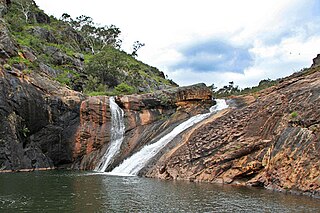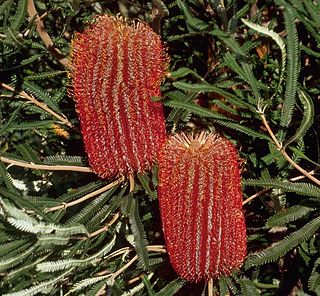
John Forrest National Park is a national park in the Darling Scarp, 24 km (15 mi) east of Perth, Western Australia. Proclaimed as a national park in November 1900, it was the first national park in Western Australia and the second in Australia after Royal National Park.

Karijini National Park is an Australian national park centred in the Hamersley Ranges of the Pilbara region in the northwestern section of Western Australia. The park is located just north of the Tropic of Capricorn, approximately 1,055 kilometres (656 mi) from the state's capital city, Perth. Formerly known as Hamersley Range National Park, the park was officially renamed in 1991.

The Serpentine National Park is a national park located on the Darling Scarp, approximately 55 kilometres (34 mi) southeast of Perth in Western Australia in Australia. The depth of the falls has been undetermined, and is shrouded with conspiracy and enigmatism.

Walpole-Nornalup National Park is a national park in the South West region of Western Australia, 355 km (221 mi) south of Perth. It is famous for its towering karri and tingle trees. red tingle trees are unique to the Walpole area. The park is part of the larger Walpole Wilderness Area that was established in 2004, an international biodiversity hotspot.

Cleland Conservation Park is a protected area located in the Adelaide Hills, South Australia about 22 kilometres (14 mi) south-east of the Adelaide city centre. Cleland Conservation Park conserves a significant area of natural bushland on the Adelaide Hills face and includes the internationally popular Cleland Wildlife Park and the popular tourist destinations of Mount Lofty summit and Waterfall Gully. It is maintained by the South Australian Department of Environment, Water and Natural Resources (DEWNR).
The Wildlife Conservation Act 1950 is an act of the Western Australian Parliament that provides the statute relating to conservation and legal protection of flora and fauna. It was replaced by the Biodiversity Conservation Act 2016 on 3 December 2016 and finally repealed as of January 1, 2019 when the Biodiversity Conservation Act 2016 and the Biodiversity Conservation Regulations 2018 became current

Banksia brownii, commonly known as feather-leaved banksia or Brown's banksia, is a species of shrub that grows in southwest Western Australia. Department of Environment and Conservation. An attractive plant with fine feathery leaves and large red-brown flower spikes, it usually grows as an upright bush around two metres (7 ft) high, but can also occur as a small tree or a low spreading shrub. First collected in 1829 and published the following year, it is placed in Banksiasubgenus Banksia, section Oncostylis, series Spicigerae. There are two genetically distinct forms.

Banksia acanthopoda is a species of shrub in the family Proteaceae. It grows as a small spreading shrub to 2 m high and has prickly leaves and yellow composite flower heads, called inflorescences, composed of 50 to 60 individual yellow flowers. Flowering takes place in the southern hemisphere winter. Endemic to Western Australia, it occurs only in a few populations in the vicinities of Woodanilling, Katanning and Darkan. Because of its rarity, it is classed as "Priority Two" conservation flora by Western Australia's Department of Environment and Conservation.
The Declared Rare and Priority Flora List is the system by which Western Australia's conservation flora are given a priority. Developed by the Government of Western Australia's Department of Environment and Conservation, it is used extensively within the department, including the Western Australian Herbarium. The herbarium's journal, Nuytsia, which has published over a quarter of the state's conservation taxa, requires a conservation status to be included in all publications of new Western Australian taxa that appear to be rare or endangered.
The Botanic Gardens and Parks Authority is a Western Australian Government authority charged with the administration of Kings Park and Bold Park.
The Australian Wildlife Conservancy (AWC) is an Australian independent, non-profit organisation, working to conserve threatened wildlife and ecosystems in Australia. This is principally achieved through the acquisition of extensive areas of land on which to establish conservation reserves or by entering into partnerships with government and Indigenous groups to manage landscapes for effective conservation. AWC currently manage 28 sanctuaries for wildlife conservation that cover over 4.8 million hectares of land across Australia.

Lambertia orbifolia, commonly known as the roundleaf honeysuckle, is a shrub or small tree that is endemic to the south-west of Western Australia. It has more or less circular leaves and groups of between four and six orange-red flowers.

Kellidie Bay Conservation Park is a protected area in the Australian state of South Australia, located on the west coast of Eyre Peninsula immediately east of the town centre in Coffin Bay and immediately adjoining the south coast of Kellidie Bay in the localities of Coffin Bay, Kellidie Bay and Wangary.
Gregory John Keighery is an Australian botanist. Since 2003 he has been a senior research scientist at the Science and Conservation Division of the Department of Biodiversity, Conservation and Attractions of Western Australia. His main expertise is in the native plants of Western Australia, particularly weed flora and the Apiaceae, Liliaceae and Myrtaceae.

The Department of Parks and Wildlife (DPaW) was the department of the Government of Western Australia responsible for managing lands described in the Conservation and Land Management Act 1984 and implementing the state's conservation and environment legislation and regulations. The minister responsible for the department was the Minister for the Environment.
Director of National Parks is a government-owned corporation of the Australian government responsible for the management of a portfolio of terrestrial and marine protected areas proclaimed under the Environment Protection and Biodiversity Conservation Act 1999. The agency is a corporation sole.

The Department of Biodiversity, Conservation and Attractions (DBCA) is the Western Australian government department responsible for managing lands and waters described in the Conservation and Land Management Act 1984, the Rottnest Island Authority Act 1987, the Swan and Canning Rivers Management Act 2006, the Botanic Gardens and Parks Authority Act 1998, and the Zoological Parks Authority Act 2001, and implementing the state's conservation and environment legislation and regulations. The Department reports to the Minister for Environment and the Minister for Tourism.
Hakea oligoneura is a small rare shrub known from only a few populations south of Perth, Western Australia growing exclusively on coastal limestone ridges. It has cream-white flowers and stiff, thick yellow-greenish leaves.

Rockingham Lakes Regional Park is a conservation park approximately 40 kilometers south of Perth, Western Australia, located within the City of Rockingham. The park, established in 1997, covers a non-continuous area of 4,270 hectares and occupies approximately 16 percent of the area of the City of Rockingham.
The Australian Sikh Heritage Trail, a group of interconnected pathways in Adenia Park, Riverton, Western Australia, is a monument commemorating the history of Sikhs in Australia. The location, adjacent to the Canning River, is significant as the heritage-listed Sikh cremation site. The winding trail features interpretive signage, plaques, benches, a sheltered area, and a boardwalk by the river. Information on the signs is organised by theme, such as Sikh farmers, Sikh wrestlers, Sikh Anzacs, Sikh hawkers and Sikh entrepreneurs.












